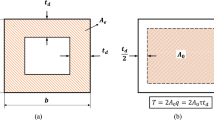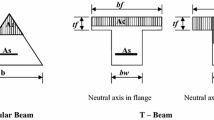Abstract
In T-beams the force transfer from the web into the flange has to be studied. The general design procedure is based on a strut-and-tie (or a stress field) model which comprises spreading compressive and transverse tensile forces. As is known, strut-and-tie models represent the force flow within a structural member at ultimate. This procedure is sufficient for design purposes and in general, leads to safe results. For the assessment of a structure it may be worthwhile to improve the accuracy. For this purpose both web and flange have to be looked at more in detail. An advanced method for the analysis of webs in shear is the Generalized Stress Field Approach [1]. This approach can be utilized for treating flanges, where the classical assumptions have to be adapted; in particular by considering the strain dependence of the concrete compressive strength and thus, defining a representative strain value. In the present contribution background and details of these aspects are given, and the corresponding calculation procedure is described. Theoretical results are compared with experimental data and show a reasonably good agreement. However, as the number of sufficiently documented tests is very limited no concluding findings are attained.
Similar content being viewed by others
References
Sigrist V. Generalized stress field approach for analysis of beams in shear. ACI Structural Journal, 2011, 108(4): 479–487
DIN EN 1992-1-1:2011-01: Eurocode 2: Bemessung und Konstruktion von Stahlbeton- und Spannbetontragwerken-Teil 1-1: Allgemeine Bemessungsregeln und Regeln für den Hochbau, CEN, European Standard, 2011
Bachmann H. Längsschub und Querbiegung in Druckplatten von Betonträgern, Beton- und Stahlbetonbau. 1978, 73(3), March
fib Model Code 2010 — Final draft, Volume 2, fib Bulletin No. 66, 2012
Marti P, Alvarez M, Kaufmann W, Sigrist V. Tension chord model for structural concrete. Structural Engineering International, 1998, 8(4): 287–298
Kaufmann W, Marti P. Structural concrete: Cracked membrane model. Journal of Structural Engineering, 1998, 124(12): 1467–1475
Kaufmann W. Strength and deformations of structural concrete subjected to in-plane shear and normal forces. Dissertation for the Doctoral Degree. Report No. 234, Institute of Structural Engineering, Zurich: ETH Zurich, 1998, 147
Vecchio F J, Collins M P. The Response of Reinforced Concrete to In-Plane Shear and Normal Stresses. Publication No. 82-03, Department of Civil Engineering, University of Toronto, Toronto, March 1982, 332
Vecchio F J, Collins M P, Aspiotis J. High-strength concrete elements subjected to shear. ACI Structural Journal, 1994, 91(4): 423–433
André H M O. Toronto/Jajima study on scale effects in reinforced concrete element. Dissertation for the Doctoral Degree. Toronto: University of Toronto, Toronto, 1987, 267
Khalifa J. Limit analysis and design of reinforced concrete shell elements. Dissertation for the Doctoral Degree. Toronto: University of Toronto, 1986, 314
Kirschner U, Collins MP. Investigating the Behaviour of Reinforced Concrete Shell Elements. Publication No. 86-09, Department of Civil Engineering, University of Toronto, Toronto, 1986, 210
Marti P, Meyboom J. Response of prestressed concrete elements to in-plane-shear forces. ACI Structural Journal, 1992, 89(5): 503–514
Ohmori N, Takahashi T, Tsubota H, Inoue N, Kurihara K, Watanabe S. Experimental studies on non-linear behaviours of reinforced concrete panels subjected to in-plane shear. Journal of Structural and Construction Engineering, 1989, 403: 105–118 (in Japanese)
Pang X, Hsu T T C. Constitutive Laws of Reinforced Concrete in Shear. Department of Civil and Environmental Engineering, University of Houston, Research Report UHCEE 92-1, Houston, 1992, 180
Collins M P, Porasz A. Shear design for high-strength concrete. Comité Euro-International du Béton, CEB Bulletin d’Information, 1989, 193: 77–83
Zhang L, Hsu T T C. Behaviour and analysis of 100MPa concrete membrane elements. Journal of Structural Engineering, 1998, 124(1): 24–34
Belarbi A, Hsu T T C. Constitutive laws of softened concrete in biaxial tension-compression. ACI Structural Journal, 1995, 92(5): 562–573
Bentz E C, Vecchio F J, Collins M P. Simplified modified compression field theory for calculating shear strength of reinforced concrete elements. ACI Structural Journal, 2006, 103(4): 614–624
Marti P. Basic tools of reinforced concrete beam design. ACI Structural Journal, 1985, 82(1): 46–56
Schlaich J, Schäfer K. Towards a consistent design of structural concrete. PCI Journal, 1987, 32(3): 75–150
Muttoni A, Schwartz J, Thürlimann B. Design of Concrete Structures with Stress Fields. Basel: Birkhäuser Verlag, 1997
DIN EN 1992-1-1/NA:2013-04: Nationaler Anhang — National festgelegte Parameter — Eurocode 2: Bemessung und Konstruktion von Stahlbeton- und Spannbetontragwerken- Teil 1-1: Allgemeine Bemessungsregeln und Regeln für den Hochbau. DIN, European Standard, 2013
Tizatto V, Shehata L C D. Longitudinal shear strength of wide compression flanges. Materials and Structures, 1990, 23(1): 26–34
Sigrist V, Bentz E, Fernández Ruiz, M, Foster S, Muttoni A. Background to the Model Code 2010 Shear Provision — Part I: Beams and Slabs. Structural Concrete, 2013 14(3): 195–203
Author information
Authors and Affiliations
Corresponding author
Rights and permissions
About this article
Cite this article
Schütte, B., Sigrist, V. Shear assessment of compression flanges of structural concrete T-beams. Front. Struct. Civ. Eng. 8, 354–361 (2014). https://doi.org/10.1007/s11709-014-0082-z
Received:
Accepted:
Published:
Issue Date:
DOI: https://doi.org/10.1007/s11709-014-0082-z




